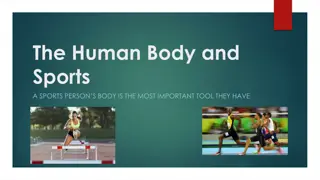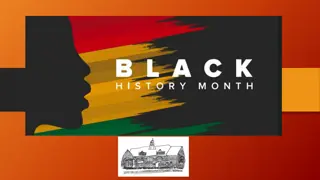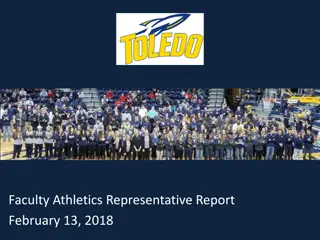Trailblazing Black Athletes in the History of British Sports
Learn about the inspiring stories of James Peters, the first black rugby player for England who faced racial discrimination, and Eddie Parris, Wales' first black international footballer. These pioneering athletes overcame challenges to make an impact in British sports history.
Download Presentation

Please find below an Image/Link to download the presentation.
The content on the website is provided AS IS for your information and personal use only. It may not be sold, licensed, or shared on other websites without obtaining consent from the author.If you encounter any issues during the download, it is possible that the publisher has removed the file from their server.
You are allowed to download the files provided on this website for personal or commercial use, subject to the condition that they are used lawfully. All files are the property of their respective owners.
The content on the website is provided AS IS for your information and personal use only. It may not be sold, licensed, or shared on other websites without obtaining consent from the author.
E N D
Presentation Transcript
LOOKING BACK LOOKING BACK AT SPORTS AT SPORTS
James Peters The 1st Black Rugby Player James Peters (August 1879 26 March 1954) was an English rugby union player and, later, a rugby league player. He is notable as the first black man to play rugby union for England. He was also known as Darkie Peters . James Peters Jamaican father, George, had been mauled to death in a training cage by lions. His mother was Hannah Gough from Wem in Shropshire. He found himself in Fegan s orphanage in Southwark and the Little Wanderers Home in Greenwich. Greenwich Admirals Rugby League Club now celebrate Peters life with an annual challenge game. Peters worked in printing and his trade brought him to Bristol, where we played for Bristol Rugby Club. Peters then moved on to Plymouth. He played rugby union for Devon, and in 1906 was to play the South Africans in front of 20,000 fans at the Plymouth County ground. However, tourists had belatedly noticed Peters colour and were seething at playing with a black man. Initially, they refused to play but eventually the South African High Commissioner , who feared a riot if the game was cancelled, persuaded the team to play. In 1906, England played South Africa for the first time; James Peters was withdrawn from the England squad after the South Africans objected to playing against a black player. On 17 March 1907, Peters played for England against Scotland. The Sportsman commented that the dusky Plymouth man did many good things, especially in passing. However, The Yorkshire Post pointed out, his selection is by no means popular on racial grounds . He was to play a further game, against France, in which he scored a try. Six weeks after playing against South Africa, for Devon, he was not picked for the next game against South Africa on racial grounds and was not to play another game for England. In 1910 Peters lost three fingers in a dockyard accident, but continued to play until 1912. It was not injury, but politics that forced James Peters out of rugby union. Clubs in the South West of England attempted to join the Northern Union (later Rugby League), form a Western League of the Northern Union with competitive fixtures. He was suspended for accepting payment from Devon Rugby Club, which was illegal according to the codes of rugby union. Many players including Peters and also RFC Plymouth were suspended by RFU. Plymouth Ground closed signalling the end of Plymouth RFC. The rules of professionalism often owed more to politics than finance. Peters, by then 34 and disillusioned with rugby union, was accepted into rugby league. Returning to his native North West of England, Peters played for Barrow in 1913, and then transferred to James Peters the 1st Black Rugby PlayerSt. Helens in 1914 until his retirement from rugby.
Eddie Parris Wales first black footballer John Edward Parris (31 January 1911 1971), known as Eddie or Ted Parris, was a Welsh international footballer, who played for Bradford Park Avenue, AFC Bournemouth, Luton Town, Bath City, Northampton Town and Cheltenham Town. He was the first black player to represent Wales in an international. His parents had come to Wales from Jamaica. He was born in or near Chepstow, Monmouthshire, Wales, possibly at Pwllmeyric. He played for Chepstow Town F.C. before his talents were spotted by scouts for Bradford Park Avenue F.C., at the time a leading club, and he was signed as a triallist in 1928. He made his debut in January 1929, scoring his team s only goal in a drawn F.A. Cup match against Hull, and thereafter established a regular first-team place at left wing. In his career at Bradford Park Avenue, he played 142 League and Cup games and scored 39 goals. In December 1931 Parris made his first and only appearance for Wales against Ireland in Belfast, becoming the first black player to represent Wales in an international. Although sometimes cited as the first black player to play for any of the home countries , research now suggests that in fact the first was the Scotland player Andrew Watson. Parris suffered an injury in 1934, and later played for Bournemouth (1934 37), Luton, Northampton, Bath City, Cheltenham Town and Gloucester City. He later worked in an aeroplane factory, and died in Gloucestershire, England in 1971.
Remembering The Greatest: Muhammed Ali Muhammed Ali was more than just a Boxer . He was a Black, Muslim man in Pre-Civil Rights Era America and he would go on to be an activist for the remainder of his life. Erasing these facts not only erases his importance to Black people worldwide, but the prejudice and struggles Ali endured. When asked why he would not join the US Army draft to fight in Vietnam, Ali said; My enemy is white people, not Viet Cong, Chinese or Japanese. You are my opposer when I want freedom, you (are) my opposer when I want Justice, you (are) my opposer when I want equality. You won t even stand up for me in America for my Religious beliefs, and you want me to go somewhere and fight, but you won t even stand up for me here in America. Muhammed Ali was called a terrorist for his affiliation with the Nation of Islam, Radical for his close relationship with Malcom X and was deemed un-American for his name change (from Cassius Clay), despite his Gold medal at the 1960 Olympics for the USA. Muhammed Ali did not transcend race . Ali was the Blackest version of himself, and was proud to be. Ali s pride is what made him a champion not just in the ring and realm of Boxing, but as an Activist and as a campaigner of Civil Rights movement in both America, and across the world. To remember Muhammed Ali, is to remember who he was, more so that what he became. Ali may have become a three time world heavyweight champion, he may have become a Muslim, a Civil Rights Campaigner, a world megastar, a sports personality of the century, a husband and father, an Olympic Gold medalist, a draft evader , a conscientious objector, a counter-culturalist, a suffer of Parkinson s disease, a suicide preventer. But who he was, was a man that believed he was the greatest at what he did and that belief is what made him become who he is; an inspiration for generations that have been and are to come.
Clive Sullivan 1943 - 1985- Rugbys First Black Captain A Great Britain and Wales international winger, he played with both Hull and Hull Kingston Rovers in his career, and also played for Oldham, and Doncaster. He was the first black captain of the Great Britain Lions and for any national British sporting side. Clive A. Sullivan MBE was a Welsh rugby union and professional Rugby League World Cup winning footballer of the 1960s, 70s and 80s. He was the first black captain of the Great Britain Lions and for any national British sporting side. Whilst growing up in the Splott district of Cardiff as a young teenager, he required operations on his knees, feet and shoulders. Due to the extent of these operations, a rugby career seemed unlikely. Sullivan never gave up, however, and he overcame his early childhood trauma by being granted a trial by Bradford Northern Rugby League Club at the age of just 17. Rugby league club Hull, had different ideas about Sullivan and gave the young man, who boasted phenomenal speed, a chance to play rugby league. In his debut for Hull, Sullivan had an outstanding game and gained the support of the Hull club and city. Sullivan became known for his exceptional speed and the way he would outplay rugby league s finest opposition wingers. His upper-body was deceptively strong which gave him excellent cover defence. His international career took him to great heights having made his debut for Great Britain in 1967. The following year he played three World Cup matches, grabbing a hat-trick against New Zealand. In 1969, he toured Australasia, but only participated in one game due to injury. He however won a further three test caps against New Zealand in 1971. In 1972 he was handed the captaincy of Great Britain and played two tests against France. The World Cup took place that same year, and he captained Great Britain to become world champions. He scored a try in each of Great Britain s four games. Sullivan scored possibly the most famous try in the history of the World Cup to level 10-10 against Australia in the final, after a length of the field run. The 1975 Rugby League World Cup saw Sullivan lead Wales in all four matches, scoring a try in the defeat of England in the second game for the Welsh team. Wales ended up finishing 3rd in the five- team World Cup. At the age of 39 he played in the Challenge Cup Final replay at Elland Road which Hull won against Widnes. When Sullivan died of cancer in 1985 aged just 42, the city of Hull held him in such high regard that a section of the city s main approach road (the A63) between the Humber Bridge and the city centre was renamed Clive Sullivan Way in his honour. Sullivan represented Great Britain 17 times and appeared at three World Cups, 1968 and 1972 with Great Britain and in 1975 for Wales.
Andrew Watson: First Black British International Footballer Page 1 OF 2 Andrew Watson was a pupil at King s College School, where he was outstanding at sport. The journey that took Andrew to Wimbledon in 1871 started in South America and, ironically, would lead him to make another piece of football history in Merseyside. Born in Demerara, British Guiana (now Guyana) on 18 May 1857, Andrew was the son of Scottish sugar plantation manager and former slave owner Peter Miller and local girl Rose Watson. The fact that Andrew was given his mother s name implies his parents were not married. Nevertheless, before his death in 1869 Peter Miller used his wealth to send Andrew and who can only be assumed to be his two other children to England. The 1861 four-year-old Andrew was staying with 54-year-old widow Elizabeth Buchanan in Staffordshire, along with 11-year-old Annette Watson and Emma McLagan, 19 the third of the three visitors to be listed as born in Georgetown, Demerara. Peter Miller left his children 35,000 in his will the equivalent of many millions today which is likely to have helped pay for Andrew to attend Heath Grammar School in Halifax. In the 1871, Andrew is listed as one of eight boarders at Heath in the household of Rev Thomas Cox, who had married 39-year-old Elizabeth Buchanan in 1857. It s possible that both Elizabeth Buchanans had married into the same family, whose members were direct relations of Peter Miller. Although this has yet to be proved, King s College School records reveal that Andrew had moved to Wimbledon by the start of the 1871/72 school year. Before Andrew made his international debut for Scotland in a 6-1 victory over England on 12 March 1881 at the Kennington Oval, he had also demonstrated as much talent in the classroom at King s College School as he had on the football pitch. Andrew left Wimbledon in 1875 to study natural philosophy, mathematics, civil engineering and mechanics at Glasgow University, but would return to London later in his life. Andrew left Glasgow University after just one year because while in Scotland he came to national prominence as a talented footballer. He joined Queen s Park the country s premier side from Parkgrove and won his first medal in the 1880 Glasgow Charity Cup final.
Andrew Watson: First Black British International Footballer Page 2 of 2 Andrew won a total of three international caps for Scotland, which would have been more had he not moved back to London in 1882 at a time when only home-based Scots were selected for the national side. Tragedy struck Andrew in the autumn of 1882 when his wife Jessie, who he married in 1877, died. Their two children were sent back to Glasgow to live with their grandparents, leaving Andrew to combine his engineering career with playing football at a high level. For the next three seasons he played in the FA Cup for London side Swifts, getting as far as the quarter-finals, and turning out on occasion for other clubs, including Brentwood and Pilgrims. More significantly in terms of his social status, he was sufficiently well regarded not just as a player but as a gentleman amateur footballer to be invited in to join the exclusive Corinthians club. He toured with them twice, the highlight being an 8-1 crushing of FA Cup holders Blackburn Rovers in 1884. As a man of independent means, Andrew could afford to travel regularly to Glasgow to visit his children and play for Queen s Park, mostly in charity cup ties but also at the opening of Hampden Park. He came back to Scotland for a year to take part in Queen s Park s successful campaign, which brought him his third Scottish Cup winner s medal in 1886. In the summer of 1887, Andrew and his second wife Eliza Kate Tyler moved from Glasgow to Liverpool, where he worked as a maritime engineer and played for Bootle FC, an ambitious club who were Everton s main rivals and reached the FA Cup fifth round. Bootle offered wages and signing-on fees to a number of prominent players, with Andrew Watson the star attraction. While the amount of money Andrew received from Bootle pales into insignificance when compared with the wages modern day international football stars receive, the payments were enough to secure Andrew another place in football history as the first black professional footballer. From his Merseyside base, Andrew spent the next 20 years working on ships and sat exams to qualify as an engineer. Andrew, Eliza and their two children, Henry and Phyllis, moved back to London after his retirement and settled in Kew, where he died of pneumonia at 88 Forest Road on 8 March 1921, aged 64. Andrew Watson, the first black international and professional footballer, is buried in Richmond Cemetery just seven miles from King s College School, where his sporting talent was first noted.
A True American Hero Jesse Owens Page 1 of 6 The most famous athlete of his time, his stunning triumph at the 1936 Olympic Games captivated the world even as it infuriated the Nazis. Despite the racial slurs he endured, Jesse Owens grace and athleticism rallied crowds across the globe. But when the four-time Olympic gold medalist returned home, he could not even ride in the front of a bus. In 1936 African American sprinter Jesse Owens amazed the world by breaking Olympic records and winning four gold medals in Berlin, the headquarters of Hitler s Nazi regime. However, in classic Olympic fashion, Owens became known not only for his athletic triumphs, but for his epic embrace with Aryan German competitor Luz Long and for the social barriers he broke down in the face of Hitler s Nazi regime. Rather than protesting Hitler s Games, Owens used his position in the spotlight to display the greatness and compassion that can be achieved outside of the political and cultural constraints of society. Childhood James Cleveland Owens was the youngest of ten children, three girls and seven boys, born to Henry Cleveland Owens and Mary Emma Fitzgerald in Oakville, Alabama on September 12, 1913. J.C., as he was called, was nine years old when the family moved to Cleveland, Ohio for better opportunities, as part of the Great Migration, when 1.5 million African Americans left the segregated South. When his new teacher asked his name (to enter in her roll book), he said J.C. , but because of his strong Southern accent, she thought he said Jesse . The name took, and he was known as Jesse Owens for the rest of his life.
A True American Hero Jesse Owens Page 2 of 6 As a boy and youth, Owens took different jobs in his spare time: he delivered groceries, loaded freight cars and worked in a shoe repair shop while his father and older brother worked at a steel mill. During this period, Owens realized that he had a passion for running. Throughout his life, Owens attributed the success of his athletic career to the encouragement of Charles Riley, his junior high track coach at Fairmount Junior High School. Since Owens worked in a shoe repair shop after school, Riley allowed him to practice before school instead. Owens first came to national attention when he was a student of East Technical High School in Cleveland; he equalled the world record of 9.4 seconds in the 100-yard (91 m) dash and long-jumped 24 feet 9 1 2 inches (7.56 metres) at the 1933 National High School Championship in Chicago. Owens attended Ohio State University after employment was found for his father, ensuring the family could be supported. Affectionately known as the Buckeye bullet, Owens won a record eight individual NCAA championships, four each in 1935 and 1936. (The record of four gold medals at the NCAA was equaled only by Xavier Carter in 2006, although his many titles also included relay medals.) Though Owens enjoyed athletic success, he had to live off campus with other African-American athletes. When he traveled with the team, Owens was restricted to ordering carry-out or eating at black- only restaurants. Similarly, he had to stay at blacks-only hotels. Owens did not receive a scholarship for his efforts, so he continued to work part-time jobs to pay for school.
A True American Hero Jesse Owens Page 3 of 6 Owens s greatest achievement came in a span of 45 minutes on May 25, 1935, during the Big Ten meet at Ferry Field in Ann Arbor, Michigan, where he set three world records and tied a fourth. He equalled the world record for the 100 yard dash (9.4 seconds); and set world records in the long jump (26 ft 8 1 4 in/8.13 m, a world record that would last 25 years); 220-yard (201.2 m) sprint (20.3 seconds); and 220-yard (201.2m) low hurdles (22.6 seconds, becoming the first to break 23 seconds).In 2005, NBC sports announcer Bob Costas and University of Central Florida professor of sports history Richard C. Crepeau both chose these wins on one day as the most impressive athletic achievement since 1850. Berlin Olympics In 1936, Owens arrived in Berlin to compete for the United States in the Summer Olympics. Adolf Hitler was using the games to show the world a resurgent Nazi Germany. He and other government officials had high hopes that German athletes would dominate the games with victories (the German athletes achieved a top of the table medal haul). Meanwhile, Nazi propaganda promoted concepts of Aryan racial superiority and depicted ethnic Africans as inferior.
A True American Hero Jesse Owens Page 4 of 6 Owens surprised many by winning four gold medals: On August 3, 1936, he won the 100m sprint, defeating Ralph Metcalfe; on August 4, the long jump (later crediting friendly and helpful advice from Luz Long, the German competitor he ultimately defeated); on August 5, the 200m sprint; and, after he was added to the 4 x 100 m relay team, following a request by the Germans to replace a Jewish-American sprinter, he won his fourth on August 9 (a performance not equalled until Carl Lewis won gold medals in the same events at the 1984 Summer Olympics). Just before the competitions, Owens was visited in the Olympic village by Adi Dassler, the founder of the Adidas athletic shoe company. He persuaded Owens to use Adidas shoes, the first sponsorship for a male African-American athlete. The long-jump victory is documented, along with many other 1936 events, in the 1938 film Olympia by Leni Riefenstahl. On the first day, Hitler shook hands only with the German victors and then left the stadium. Olympic committee officials insisted Hitler greet every medalist or none at all. Hitler opted for the latter and skipped all further medal presentations. On reports that Hitler had deliberately avoided acknowledging his victories, and had refused to shake his hand, Owens said at the time: Hitler had a certain time to come to the stadium and a certain time to leave . It happened he had to leave before the victory ceremony after the 100 meters. But before he left I was on my way to a broadcast and passed near his box. He waved at me and I waved back. I think it was bad taste to criticize the man of the hour in another country .
A True American Hero Jesse Owens Page 5 of 6 Away from the public eye, Hitler expressed his true feelings and disgust at Owens. Albert Speer, Hitler s architect and later war armaments minister, later recollected: Each of the German victories, and there were a surprising number of these, made him happy, but he was highly annoyed by the series of triumphs by the marvellous coloured American runner, Jesse Owens. People whose antecedents came from the jungle were primitive, Hitler said with a shrug; their physiques were stronger than those of civilized whites and hence should be excluded from future games. Owens was allowed to travel with and stay in the same hotels as whites, while at the time blacks in many parts of the United States were denied equal rights. After a New York City ticker-tape parade of Fifth Avenue in his honour, Owens had to ride the freight elevator at the Waldorf-Astoria to reach the reception honouring him. Owens said, Hitler didn t snub me it was FDR who snubbed me. The president didn t even send me a telegram. On the other hand, Hitler sent Owens a commemorative inscribed cabinet photograph of himself. Jesse Owens was never invited to the White House nor were honours bestowed upon him by President Franklin D. Roosevelt (FDR) or his successor Harry S. Truman during their terms. In 1955, President Dwight D. Eisenhower honoured Owens by naming him an Ambassador of Sports.
A True American Hero Jesse Owens Page 6 of 6 Post-Olympics He was quoted saying the secret behind his success was I let my feet spend as little time on the ground as possible. From the air, fast down, and from the ground, fast up. After the games had finished, the Olympic team and Owens were all invited to compete in Sweden. He decided to capitalize on his success by returning to the United States to take up some of the more lucrative commercial offers. United States athletic officials were furious and withdrew his amateur status, ending his career immediately. Owens was angry, saying, A fellow desires something for himself. Prohibited from amateur sporting appearances to bolster his profile, Owens found the commercial offers all but disappeared. In 1946, he joined Abe Saperstein in the formation of the West Coast Baseball Association (WCBA), a new Negro baseball league; Owens was Vice-President and the owner of the Portland (Oregon) Rosebuds franchise. He toured with the Rosebuds, sometimes entertaining the audience in between doubleheader games by competing in races against horses The WCBA disbanded after only two months. Owens helped promote the exploitation film Mom and Dad in black neighborhoods. He tried to make a living as a sports promoter, essentially an entertainer. He would give local sprinters a ten- or twenty-yard start and beat them in the 100-yd (91-m) dash. He also challenged and defeated racehorses; as he revealed later, the trick was to race a high-strung thoroughbredthat would be frightened by the starter s shotgun and give him a bad jump. Owens said, People say that it was degrading for an Olympic champion to run against a horse, but what was I supposed to do? I had four gold medals, but you can t eat four gold medals.
Hope Powell, OBE Football Manager Former Coach of the England Women s National Football Powell played for Millwall Lionesses, for nine years and won the FA Women s Cup three times, including the league and Cup double, as captain of Croydon in 1996. Before becoming the England Manger, Powell was a distinguished player, earning 66 caps for England, mostly as an attacking midfielder, she scored 35 goals. Powell made her England debut at the age of 16, she played in the 1995 FIFA Women s World Cup, England s first World Cup appearance where she was the England vice-captain. Appointed as the first ever full-time national coach in 1998 she led England to the 2001 European Championship and the quarter-finals of the 2005 European Championship, the 2007, and 2011 World Cup Finals. As well as managing the England Senior team, she oversees the whole set-up from Under- 15s to the Under-21s, a coach mentoring scheme and The FA s National Player Development Centre at Loughborough University. In 2002, Powell was appointed OBE, and then CBE in 2011. She was inducted into the English Football Hall of Fame in 2003. In 2007, Powell led the England Women s Team to the quarter-finals in china in 2007, where they were beaten by the Americans. England were to suffer another quarter-final knockout in the 2011 World Cup Finals, losing on penalties to the French. In 2012 Hope Powell led Team GB at the London Olympics, this was the first a United Kingdom team had played. Team GB made it to the Quarter Finals again but were beaten 2- 0 by Canada. After mounting criticism of her record, which was actually reasonably good, Powell was sacked as England Manager in 2013. After 15 years at the helm of England, Powell is now an advisor to FIFA and works with charities such as Football Action. She is vocal about the need to improve opportunities for women coaches in football. In 2015 she spoke at FIFA's inaugural women s football and leadership conference, pointing out the high number of female coaches losing their jobs to male counterparts.
Jessica Ennis - Hill Jessica was born on 28 January 1986 is one of two daughters of Vinnie Ennis and Alison Powell and has a younger sister named Carmel. Jessica is of mixed parentage, her father Vinnie was originally from Jamaica and her mother was a social worker from Derbyshire. Ennis went to School at Sharrow Primary School and King Ecgbert School in Dore. Which is on the outskirts of the Sheffield. Jessica stayed at school enrolling in the 6th Form. There she took her GCSEs gaining three A-Levels, before going on to study psychology at the University of Sheffield and graduating in 2007. Her Parents introduced her to athletics by taking her to a Start:Track event at Sheffield s Don Valley Stadium during the 1996 school summer holidays. Jessica Joked that she thought I think my mum and dad wanted me out of the house! . This is where Jessica won her first athletics prize a pair of trainers. More significantly, it was where she met the man who was to become her coach, Toni Minichiello. Jessica proved to be a natural at sport and joined the City of Sheffield Athletic Club the following year, aged eleven. By November of 2000, aged just fourteen, she won the Sheffield Federation for School Sports Whitham Award for the best performance by a Sheffield athlete at the National Schools Championships, where she won the high jump competition. n August 2012 Jessica Ennis won the gold medal in the heptathlon at the London 2012 Olympic Games. Beating silver medallist Lilli Schwarzkopf by 306 points. Her first-day score included two personal bests: 12.54 seconds in the 100 metres hurdles and 22.83 seconds in the 200 metres. The time she set in the 100 metres hurdles was a new British record and the fastest time ever run in a heptathlon. Ennis achieved another personal best of 47.49 metres in the javelin and won the final event, the 800 metres, in a time of 2:08.65. Jessica s efforts and triumphs mean she joins the many other Black British Athletes listed on the Black Presence in Britain.
Frank Bruno Frank Bruno is one of Britain s best-loved sportsmen, and arguably one of the most successful Black British boxers. Bruno was renowned for his punches, but his fame rested as much on his charm outside the ring as his power in it. Franklyn Roy Bruno was born at Hammersmith Hospital in London. The youngest of 6 children. His parents settled down in Wandsworth in London. His father, Robert, who was from Dominica passed away in 1975, while his mother Lynette is a district nurse and a Pentecostal lay preacher from Jamaica. Frank attended schools at Swaffield Primary and Oak Hill schools in Sussex where he excelled in football and athletics. He began boxing at 9 at the local Wandsworth Boys Club. During his amateur career, he amassed a 20-1 career, losing to (and eventually beating) Joe Christie while representing the Philip Game Amateur Boxing Club. His amateur career culminated with Frank boxing for Young England and becoming the youngest Amateur British Champion at 18. As a professional fighter he weighed 247lbs and stood 6 3 tall. Bruno had a great record of 40-4. He only seemed to falter during Title fights losing to Mike Tyson, Lennox Lewis, Tim Witherspoon, and James Bonecrusher Smith. Bruno fought a total of 167 rounds, winning 38 inside the distance, and 17 of those by knockout. Frank s career peaked on 3rd September 1995 when he beat Oliver McCall on points at Wembley Stadium to become the World Boxing Council Heavyweight Champion. He retired from boxing in August 1996. Frank was awarded an MBE in 1990, and is a member of Equity. Frank has since become a comedy actor.























